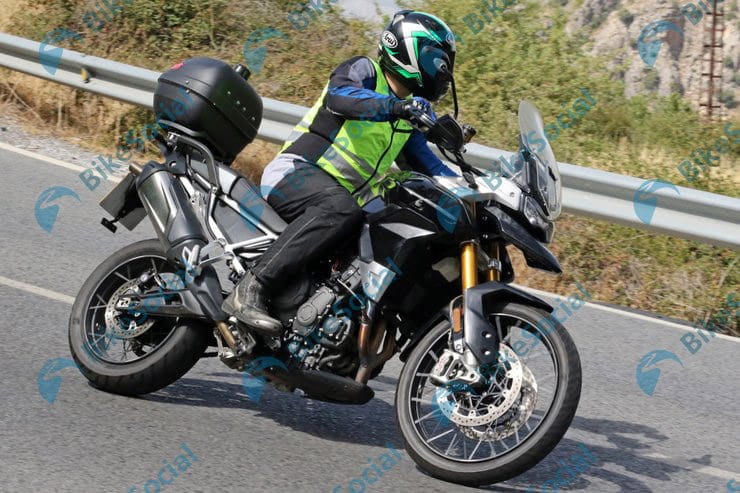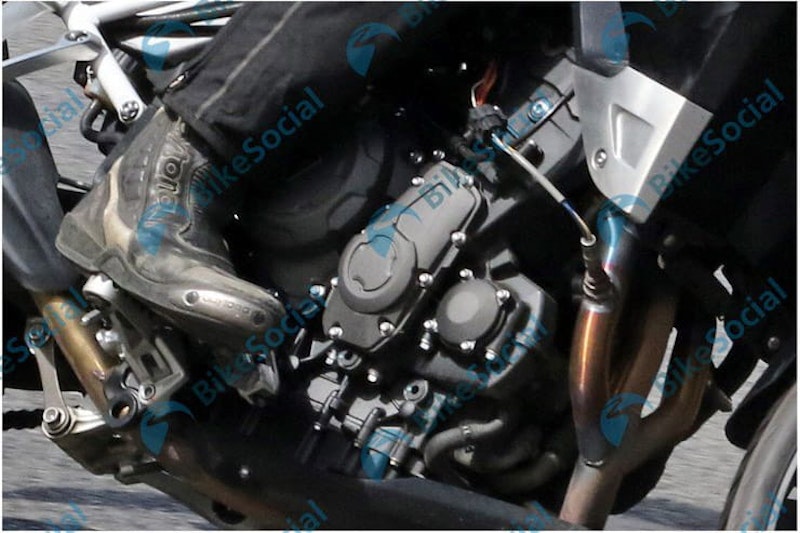New Triumph Tiger 900 spied on test
By Ben Purvis
Motorcycle Journalist
06.08.2019
Triumph is on the verge of launching a replacement for its best-selling Tiger 800 and we’ve got pictures of a near-production prototype undergoing final testing on the roads of Spain.
There’s no underestimating the importance of the smaller Tiger to Triumph. The firm sold more than 1200 of them in the UK alone last year and despite being close to replacement the existing model is still selling as strongly as ever. As many were registered in the Q1 of 2019 as the same period 12 months earlier, beating most of its rivals, so the introduction of a completely new and much improved version will come as bad news to the firm’s main competitors.
While the three-cylinder layout is carried over, you’ll struggle to find parts that are shared between the 2020 Tiger and its predecessor. The new bike gets a new chassis, better suspension, higher-spec brakes, more advanced electronics and, perhaps most importantly, a bigger, more powerful engine to go with the vastly improved styling that’s clear to see here.
We’ll start with that engine. While it’s still derived from the three-cylinder unit used in the existing Tiger 800, Triumph has given it a thorough going-through to make sure it’s both cleaner and more powerful than its predecessor. Cleaner because as a new model for 2020 it needs to meet Euro 5 rules – requiring a reduction in both exhaust and noise emissions More powerful and torquier because Triumph has given the motor a 11% capacity hike.
Where the current model has an 800cc triple, the 2020 Tiger gets a larger 888cc unit, which should be enough to ensure its power output rises from 94hp to somewhere north of 100hp. That’s important because it means the Tiger will stay on terms with the forthcoming 1084cc Honda Africa Twin, which also gets a hike from 94hp to 101hp in 2020. It also means the Tiger – which will inevitably be renamed ‘Tiger 900’ to reflect the engine changes – will beat its key German rival, BMW’s 95hp F850GS in performance terms.
To achieve the capacity increase, we understand Triumph has combined the existing Tiger 800’s crankshaft – giving a relatively long 61.9mm stroke – with the enlarged 78mm bore from the Street Triple’s 765cc. The combination means we can expect the bike’s delivery to be generally similar to the existing bike, with the peak power coming at around 9500rpm and max torque about 1500rpm lower than that, but the absolute output will be higher. The bigger bore means larger valves can be used, improving the engine’s breathing and further helping to offset any losses resulting from the need to clean up the engine’s exhaust. We’d expect the peak power to be between 100hp and 105hp, with max torque rising from 58lbft to about 64lbft.
That engine is bolted to a completely new chassis. The frame still appears to be a tubular steel trellis, but it’s redesigned and features a bolt-on subframe rather than the existing bike’s welded-on design.
Despite the larger engine, Triumph has worked to make the new Tiger more compact than its predecessor. The firm has taken a leaf from Honda’s Africa Twin playbook and swapped the single radiator of the old model for two rads, one on each side. That means there’s more space for the front wheel to move back as the suspension compresses without the need to extend the wheelbase. It also means the engine can be positioned further forward to keep the centre of gravity in the right place.
There’s new styling, too, with a slimline LED headlight marking the most notable change and giving the Tiger a much sleeker, more modern look than its predecessor. That modern look is reflected in the bike’s technology, with a full colour TFT dashboard providing a means to operate a host of tech, inevitably including Bluetooth connectivity, navigation, music control and probably Triumph’s GoPro integration to allow the control of on-board cameras.
Triumph clearly isn’t messing about when it comes to the new bike’s suspension and brakes – Showa forks and Brembo radial calipers are clear to see at the front, while the rear has a white spring that could indicate the use of a WP shock. At the back there’s clearly a remote preload adjuster, visible below the rider’s seat, showing that this model hasn’t gone as far as adding electronic adjustment.
The swingarm is completely new and appears to be a cast aluminium design, while the rear brake again comes from Brembo.
It’s worth noting that this is just one model in a much larger Tiger 900 range. This version appears to be the replacement for the Tiger 800 XCx – the more off-road oriented bike with wire wheels and a 21-inch front wheel. There will also surely be an XRx version with alloy rims and a 19-inch front, and no doubt a touring XRT and adventure-oriented XCA model in the range, too, as well as ‘Low’ versions with reduced suspension and seat heights to appeal to shorter riders.
Triumph will reveal the bike in full this Autumn, with sales likely to commence in spring next year.
Share on social media:

